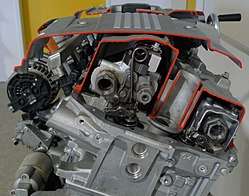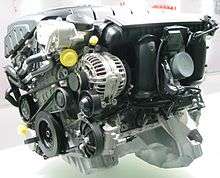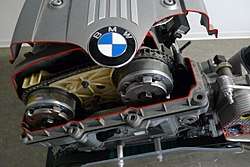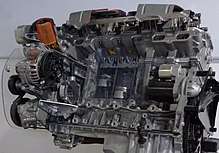BMW N52
The BMW N52 is a naturally aspirated straight-six petrol engine which was produced from 2004-2015. The N52 replaced the BMW M54 and debuted on the E90 3 Series and E63 6 Series.
| BMW N52 engine | |
|---|---|
 | |
| Overview | |
| Production | 2004–2015 |
| Layout | |
| Configuration | Straight-6 |
| Displacement | 2.5–3.0 L (153–183 cu in) |
| Block material | Magnesium-Aluminium |
| Head material | Aluminium |
| Valvetrain | DOHC, with VVT & VVL |
| Combustion | |
| Fuel type | Petrol |
| Chronology | |
| Predecessor | BMW M54 |
| Successor | BMW N53 |
The N52 was the first water-cooled engine to use magnesium/aluminium composite construction in the engine block.[1] It was also listed as one of Ward's 10 Best Engines in 2006 and 2007.[2][3][4]
In European markets, the N52 began to be phased out following the release of the BMW N53 in 2007. However, in markets such as the United States, Canada, Australia and Malaysia, the N53 was deemed unsuitable due to the high levels of sulfur in the fuel.[5] From the year 2011, the N52 began to be replaced by the BMW N20 turbocharged four-cylinder engine until production of the N52 finished in 2015.[6]
Unlike its predecessors, there is no BMW M version of the N52.
Design

Compared with its M54 predecessor, the N52 features Valvetronic (variable valve lift),[7] a lighter block due to the use of a magnesium alloy[8] and an electric water pump (replacing the belt-driven water pump)[9][10] and a variable output oil pump.[11] The redline was increased from 6,500 rpm to 7,000 rpm.[12]
Like the M54, the N52 uses electronic throttle control and variable valve timing (double-VANOS). Higher output versions of the N52 use a three-stage variable length intake manifold (also called "DISA").[13][14]
The N52 engine block is made from a combination of magnesium and aluminium.[12] Magnesium is lighter than aluminium, however it has a greater risk of corrosion from water and may creep under load at high temperatures; this makes traditional magnesium alloys not suited for withstanding the high loads to which an engine block is exposed. Therefore, BMW used a magnesium alloy for the crankcase shell, with an aluminum 'inner block' to overcome the limitations of magnesium alloys.[11][15] The cylinder liners are made of Alusil[16] and a hollow camshaft is used to reduce weight.[11]
The engine control unit (also called "DME") is a Siemens MSV70.[12]
Models





| Engine | Displacement | Power | Torque | Years |
|---|---|---|---|---|
| N52B25 | 2,497 cc (152.4 cu in) | 130 kW (174 bhp) at 5,800 rpm | 230 N⋅m (170 lb⋅ft) at 3,500-5,000 rpm | 2005-2008 |
| 150 kW (201 bhp) at 6,400 rpm | 250 N⋅m (184 lb⋅ft) at 2,750 rpm | 2007-2011 | ||
| 160 kW (215 bhp) at 6,500 rpm | 250 N⋅m (184 lb⋅ft) at 2,750-4,250 rpm | 2005-2011 | ||
| N52B30 | 2,996 cc (182.8 cu in) | 160 kW (215 bhp) at 6,100 rpm | 270 N⋅m (199 lb⋅ft) at 2,500-4,250 rpm | 2006-2010 |
| 280 N⋅m (207 lb⋅ft) at 2,500-3,500 rpm | 2010-2011 | |||
| 170 kW (228 bhp) at 6,500 rpm | 270 N⋅m (199 lb⋅ft) at 2,750 rpm | 2007-2013 | ||
| 180 kW (241 bhp) at 6,500 rpm | 310 N⋅m (229 lb⋅ft) at 2,750 rpm | 2008-2011 | ||
| 190 kW (255 bhp) at 6,600 rpm | 300 N⋅m (221 lb⋅ft) at 2,500-4,000 rpm | 2010-2011 | ||
| 190 kW (255 bhp) at 6,600 rpm | 310 N⋅m (229 lb⋅ft) at 2,600 rpm | 2009-2015 | ||
| 195 kW (261 bhp) at 6,600 rpm | 315 N⋅m (232 lb⋅ft) at 2,750-4,250 rpm | 2005-2009 | ||
| 200 kW (268 bhp) at 6,650 rpm | 315 N⋅m (232 lb⋅ft) at 2,750 rpm | 2006-2010 |
N52B25
130 kW (174 bhp) Applications:[17][18]
- 2006 E90 323i — Canada only
- 2004-2007 E60/E61 523i
- 2006-2008 E85 Z4 2.5i
150 kW (201 bhp) Applications:
- 2007-2011 E90 323i — Canada only
- 2010-2011 F10 523i
- 2009-2011 E89 Z4 sDrive23i
160 kW (215 bhp) Applications:
N52B30
The 3.0 L (183 cu in) models of the N52 have a bore of 85 mm (3.35 in), a stroke of 88 mm (3.46 in) and a compression ratio of 10.7:1. Variations in power output are often due to different intake manifolds and variations of engine management software.[19]
160 kW (215 bhp) Applications:[20]
- 2006-2007 E90/E92/E93 325i, 325xi — U.S. and Canada only
- 2006-2007 E60/E61 525i, 525xi — U.S. and Canada only
- 2006-2008 E85 Z4 3.0i — U.S. and Canada only
- 2008-2011 E82/E88 125i
- 2008-2010 E60/E61 528i, 528xi — U.S. and Canada only
- 2009-2010 E84 X1 xDrive25i
170 kW (228 bhp) Applications:
- 2007-2013 E90/E91/E92/E93 328i, 328xi — U.S. and Canada only
- 2008-2011 E82/E88 128i — U.S. and Canada only
180 kW (241 bhp) Applications:[21][22]
- 2010-2011 F10 528i
190 kW (255 bhp) Applications:[23]
- 2004-2007 E63/E64 630i
- 2004-2008 E90 330i, 330Ci, 330xi
- 2005-2008 E65/E66 730i
- 2005-2009 E60/E61 530i, 530xi
- 2009-2015 F01 730i
- 2008-2011 E89 Z4 sDrive30i
- 2009-2011 E84 X1 xDrive28i
- 2009-2012 E87 130i
- 2010-2011 F25 X3 28i
195 kW (261 bhp) Applications:
- 2005-2008 E85/E86 Z4 3.0si
- 2006-2009 E87 130i
200 kW (268 bhp) Applications:[24]
- 2006–2010 E83 X3 3.0si
- 2006-2010 E70 X5 3.0si, xDrive30i
- 2007-2010 E63/E64 630i
- 2006-2007 E90/E92/E93 330i, 330xi
N51B30
The N51 engine is a SULEV version of the N52 that was sold in parts of the United States that had SULEV legislation.[25] Differences to the N52 versions include a variable-length intake manifold ("DISA") with three stages instead of one, and a compression ratio lowered from 10.7:1 to 10.0:1.[26]
Recalls
In 2017, BMW recalled 740,000 six-cylinder models (328i, 525i), due to reports of the heater for the crankcase ventilation valve short-circuiting and causing a fire.[27]
See also
References
- "BMW Pushes Lightweight Technology with Magnesium". www.worldcarfans.com. Archived from the original on 10 February 2009. Retrieved 28 October 2017.
- "10 Best Engines 2006". www.wardsauto.com. Retrieved 21 October 2017.
- "Ward's 10 Best Engines 2007". www.wardsauto.com. Archived from the original on 22 October 2017. Retrieved 21 October 2017.
- "Ward's Auto releases annual 10 Best Engines list". autoblog.com.
- "BMW's N52 versus N53 – what are we missing?". paultan.org.
- "BMW N20 turbo 4 cylinder versus N52 naturally aspirated 6 cylinder". bimmerboost.com.
- "BMW N52 and N53 24 Valve Six Cylinder Engines". unixnerd.demon.co.uk.
- "2007 BMW 525xi". conceptcarz.com.
- "www.worldcarfans.com". BMW's New Six-Cylinder Engines - In Depth. Archived from the original on 9 February 2009.
- https://bmwtuning.co/bmw-n52-engine-problems/
- "Inside the N52 Engine". mwerks.com.
- "BMW N52B30 Engine". www.mywikimotors.com. Retrieved 22 October 2017.
- "TMS1764947 - N52 330 Intake Manifold & Software Upgrade". www.turnermotorsport.com. Retrieved 22 October 2017.
- "Genuine BMW - 11617559523KT2 Intake Manifold Upgrade Kit". www.ecstuning.com. Retrieved 22 October 2017.
- "BMW Pushes Lightweight Technology with Magnesium". www.motor1.com. Archived from the original on 29 May 2016.
- "Nikasil Cylinders". www.looking4spares.co.za. Retrieved 22 October 2017.
- "Engine specifications- N52". bmwheaven.com.
- "5'E60 523i". www.realoem.com. Retrieved 27 October 2017.
- "2007 BMW Z4". conceptcarz.com.
- "2009 BMW 1 Series - Features & Specs". edmunds.com.
- "2011 BMW 528i - Short Take Road Test". caranddriver.com.
- "Test Drive: 2011 BMW 528i". autos.ca.
- "Model selection: F'01 LCI - sedan - 730i". www.realoem.com. Retrieved 7 May 2019.
- "2007 BMW 3-series E90 Sedan RWD (2WD) range full specs". www.automobile-catalog.com. Retrieved 30 May 2018.
- "How Do I Know if I Have an N51 or N52 BMW 6-Cylinder Engine?". www.bavauto.com. Retrieved 17 August 2019.
- "BMW N51 vs N52 Engine Differences". www.tuningforbmws.com. Archived from the original on 16 August 2018. Retrieved 17 August 2019.
Note: Web page still active, but image links are broken in the current version
- Caron, Christina. "BMW Recalls Roughly a Million Vehicles at Risk of Catching Fire". New York Times. Retrieved 13 August 2018.